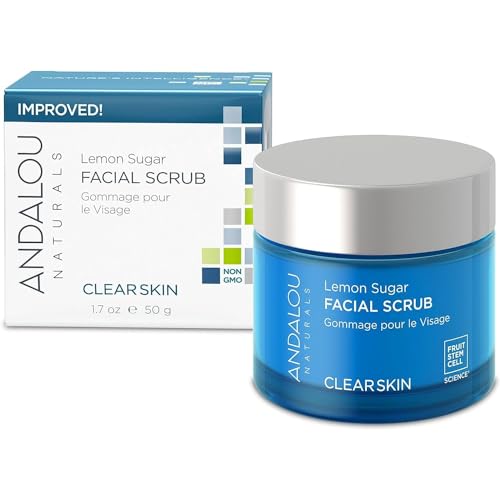
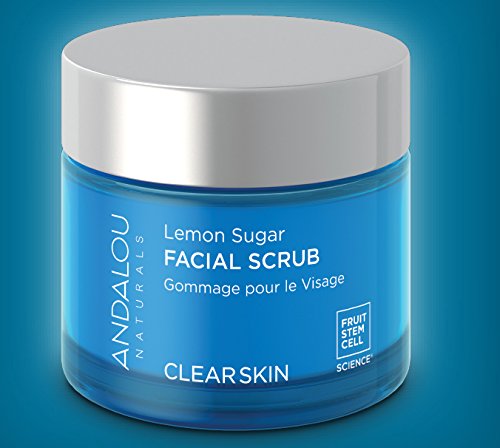
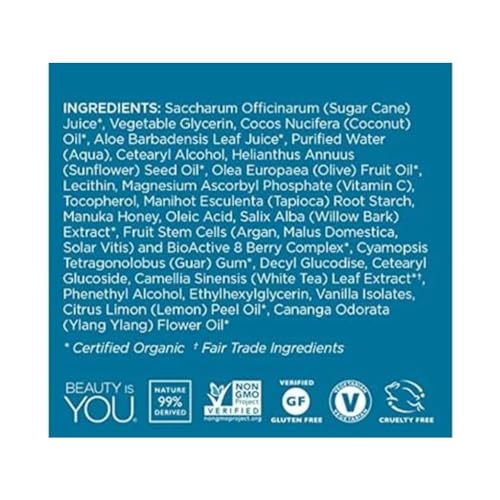
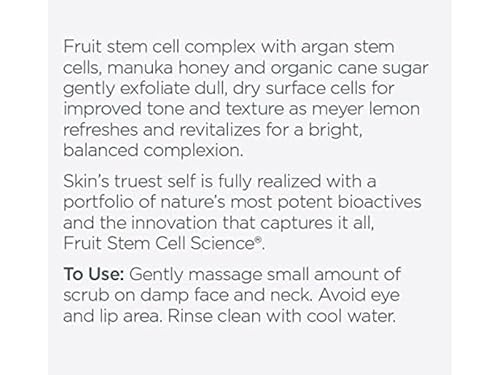

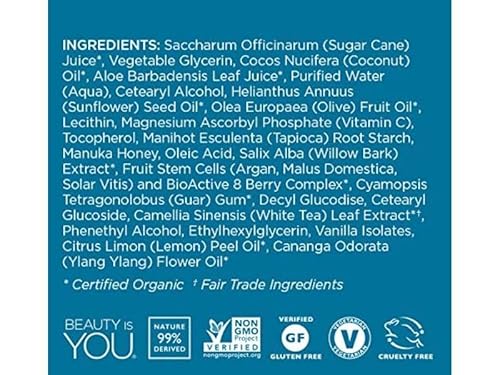

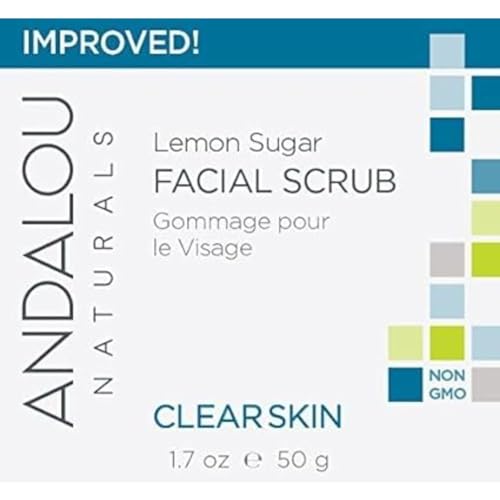
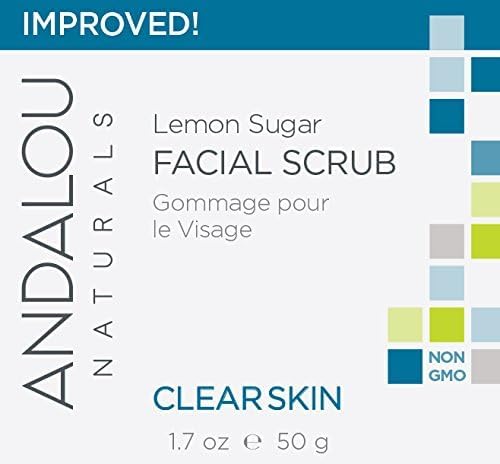
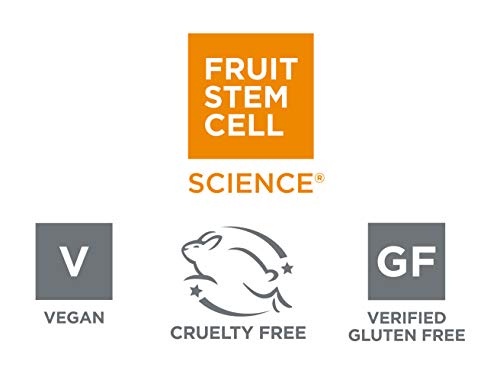
Andalou Naturals Lemon Sugar Facial Scrub - Gently Exfoliates & Purifies Skin - 1.7 oz


Cyamopsis Tetragonoloba (Guar) Gum
Medium RiskCyamopsis tetragonoloba (guar) gum is a resinous substance derived from the seeds of the guar plant. It primarily functions as a thickening and stabilizing agent in various cosmetic and personal care products, enhancing texture and consistency.
Sustai Insights
Guar gum is valued for its thickening capabilities and is derived from a renewable source, contributing to its sustainability credentials. However, it poses moderate allergenic potential and low risks for carcinogenicity and reproductive toxicity. Environmental concerns are minimal, with no significant pollutant or bioaccumulation risks identified. Regulatory status is favorable, with no major restrictions noted. Users should practice caution with sensitive individuals, and alternatives like xanthan gum may serve as effective substitutes. Overall, the risk level associated with guar gum is assessed as medium, warranting careful consideration in product formulation.
Lecithin
Medium RiskLecithin is a naturally occurring lipid found in various plant and animal tissues, primarily composed of phospholipids. It serves as an emulsifier, stabilizing mixtures of oil and water, and is commonly used in food, cosmetics, and pharmaceuticals to improve texture and extend shelf life.
Sustai Insights
Lecithin provides functional benefits as an effective emulsifier and stabilizer, enhancing product texture while being sustainably sourced from natural origins. Health risks are generally low, with moderate concerns regarding allergies and immunotoxicity but minimal cancer or reproductive toxicity risks. Environmental hazards are limited, and it is not classified as a pollutant. Regulatory bodies impose few restrictions. Overall, lecithin presents a medium risk, suggesting caution in usage, especially for sensitive individuals. Alternatives include sunflower lecithin or other plant-based emulsifiers that may offer similar benefits with reduced allergenic potential.
Phenethyl Alcohol
Medium RiskPhenethyl alcohol is an aromatic alcohol commonly used in cosmetic formulations. It functions primarily as a solvent and a preservative, contributing to product stability and enhancing the fragrance profile.
Sustai Insights
Phenethyl alcohol exhibits functional benefits as a preservative and solvent in cosmetic products, with some sustainability credentials due to its natural origin. However, it is associated with moderate allergy concerns and low risks of carcinogenicity and reproductive toxicity. Regulatory bodies have imposed specific use restrictions, highlighting the need for cautious application. Overall, the risk assessment indicates a medium risk level, warranting safe usage practices and consideration of alternatives like natural preservatives.
Cocos Nucifera (Coconut) Oil
Low RiskCocos Nucifera (Coconut) Oil is derived from the kernels of the coconut palm. It is primarily used in cosmetic formulations for its emollient and moisturizing properties, making it suitable for skin and hair care products.
Sustai Insights
Coconut oil serves as an effective moisturizer and emollient, promoting skin hydration and softness. It is sustainably sourced and biodegradable. Health risks are minimal, with low concerns regarding carcinogenicity, allergens, and reproductive toxicity. Environmental impact is also low, as it does not contribute significantly to pollution or bioaccumulation. Regulatory bodies have not issued restrictions on its use. Overall, coconut oil presents a low risk for health and environmental concerns, making it a safe ingredient in cosmetic products.
Citrus Limon (Lemon) Peel
Low RiskCitrus limon (lemon) peel is derived from the outer skin of lemons and is commonly used in cosmetic formulations for its aromatic properties and potential skin benefits. It serves primarily as a fragrance agent and may also provide antioxidant effects.
Sustai Insights
Citrus limon (lemon) peel is valued for its aromatic contributions and potential antioxidant properties, which can enhance product appeal. It has a low risk of adverse health effects, including low concerns for carcinogenicity, allergies, and irritation. Environmental risks are minimal, with no significant evidence of bioaccumulation or pollution. Regulatory assessments indicate no restrictions on use. Overall, it is considered low risk, and safe usage practices should be maintained. Alternatives may include other citrus peels or natural fragrance compounds.
Water
Low RiskWater is a clear, colorless liquid essential for various biological processes. It serves as a solvent in formulations, facilitating the dissolution of other ingredients and enhancing product texture and application. Additionally, water plays a crucial role in hydration and is a key component in many cosmetic and personal care products.
Sustai Insights
Water is an effective solvent and hydrator, contributing to the texture and efficacy of formulations. It is biodegradable and generally regarded as safe, with low concerns regarding carcinogenicity, allergies, and reproductive toxicity. However, excessive water usage can lead to environmental concerns, particularly regarding resource depletion. Regulatory bodies do not impose restrictions on water use in cosmetics. Overall, the risks associated with water are low, making it a safe and essential ingredient.
Manuka Honey
Low RiskManuka honey is honey produced by bees that collect nectar from the flowers of the Manuka tree (Leptospermum scoparium), native to New Zealand and Australia. It is known for its unique properties and is commonly used in various health and beauty products for its potential benefits.
Sustai Insights
Manuka honey offers functional benefits such as antimicrobial properties and potential wound healing effects, making it valuable in skincare and medicinal applications. While it has low risks for carcinogenicity and reproductive toxicity, concerns exist regarding allergenic potential and possible endocrine disruption. Environmental risks are minimal, with no significant pollutant or bioaccumulation concerns noted. Regulatory bodies impose few restrictions, classifying it as low risk overall. Usage should be tailored to avoid allergic reactions, and alternatives like raw honey may provide similar benefits.
Saccharum Officinarum (Sugar Cane) Juice
Low RiskSaccharum officinarum (sugar cane) juice is derived from the sugar cane plant and is primarily used as a natural sweetener in food and cosmetic products. It serves to enhance flavor and contribute to the texture and moisture content of formulations.
Sustai Insights
Sugar cane juice offers functional benefits as a natural sweetener and humectant, aiding in moisture retention. It is biodegradable and sourced sustainably. Health risks are minimal, with low concerns for carcinogenicity, allergies, or reproductive toxicity, although contamination concerns exist. Environmental impacts are low, with no significant pollutant or bioaccumulation issues. Regulatory bodies do not impose strict restrictions. Overall, it is assessed as low risk. For those seeking alternatives, other natural sweeteners like honey or agave syrup may be considered.
Olea Europaea (Olive) Oil
Low RiskOlea europaea (olive) oil is derived from the ripe fruit of the olive tree. It is commonly used in cosmetic formulations primarily as a moisturizer and emollient due to its nourishing properties for the skin. It also serves as a carrier oil for other ingredients in formulations.
Sustai Insights
Olea europaea (olive) oil offers numerous functional benefits, including effective moisturization and enhanced skin absorption properties, making it suitable for various cosmetic applications. It is a biodegradable ingredient, contributing to sustainability when sourced responsibly. Health risks are low, with minimal concerns regarding carcinogenicity, allergenic potential, and developmental toxicity. Environmental risks are also low, with no significant bioaccumulation or pollution potential noted. Regulatory bodies do not impose restrictions on its use. Overall, olive oil presents a low risk profile, making it a favorable choice in cosmetic products.
Cetearyl Glucoside
Low RiskCetearyl glucoside is a surfactant and emulsifier derived from natural sources, commonly used in cosmetic and personal care products to stabilize formulations and enhance texture. It helps to blend oil and water-based ingredients, improving product consistency and application.
Sustai Insights
Cetearyl glucoside offers functional benefits as an effective emulsifier and surfactant, facilitating product stability. Its sustainability credentials are notable, as it is biodegradable and sourced from renewable materials. Health risks are generally low, with minimal concerns for irritation and allergies. Environmental impacts are also low, posing no significant pollution or bioaccumulation risks. Regulatory status remains positive with no major restrictions reported. Safe usage practices are advised, and alternatives such as plant-derived emulsifiers may be considered. Overall, the risk level associated with cetearyl glucoside is low.
Cetearyl Alcohol
Low RiskCetearyl alcohol is a mixture of cetyl and stearyl alcohol, primarily used as an emulsifier and thickener in cosmetic formulations. It helps stabilize products, improve texture, and enhance moisturizing properties, making it common in creams and lotions.
Sustai Insights
Cetearyl alcohol offers functional benefits as an effective emulsifier and skin-conditioning agent, contributing to product stability and texture. It is generally recognized as safe, with low concerns for carcinogenicity, allergies, or reproductive toxicity. Environmental risks are minimal, as it is biodegradable and has low pollutant potential. Regulatory bodies have not imposed significant restrictions on its use. Overall, cetearyl alcohol is assessed to carry low risk, making it a suitable ingredient choice in cosmetic products.
Tocopherol, D Alpha
Low RiskTocopherol, specifically d-alpha tocopherol, is a naturally occurring form of Vitamin E. It is commonly used in cosmetic and personal care products primarily for its antioxidant properties, helping to protect formulations from oxidation and extend shelf life.
Sustai Insights
D-alpha tocopherol provides effective antioxidant benefits, contributing to product stability. It is sustainably sourced and generally regarded as safe, with low concerns regarding carcinogenicity, allergies, and reproductive toxicity. However, there are minor concerns about endocrine disruption. Regulatory bodies have not imposed significant restrictions, indicating low overall risk. Recommended usage practices include adhering to established safe concentration thresholds. Alternatives, such as other forms of Vitamin E or plant-based antioxidants, may also be considered.
Magnesium Ascorbyl Phosphate
Low RiskMagnesium ascorbyl phosphate is a vitamin C derivative used in cosmetics primarily for its antioxidant properties and skin-brightening effects. It is often included in formulations for its ability to stabilize vitamin C, enhancing its efficacy in skin care products.
Sustai Insights
Magnesium ascorbyl phosphate offers functional benefits as an effective antioxidant and skin-brightening agent, contributing to improved skin appearance. It has a low risk profile concerning health, with minimal concerns regarding carcinogenicity, allergies, and reproductive toxicity. Environmental risks are also low, with no significant pollutant or bioaccumulation potential noted. Regulatory assessments indicate no major restrictions, supporting its safe use in cosmetic products. Overall, the ingredient is assessed as low risk, with safe usage practices recommended for optimal effectiveness.
Ethylhexylglycerin
Low RiskEthylhexylglycerin is a glyceryl ether utilized primarily as a skin-conditioning agent and preservative in cosmetic formulations. It enhances the efficacy of preservatives and serves as a humectant, helping to retain moisture in the skin. This ingredient is commonly found in various personal care products.
Sustai Insights
Ethylhexylglycerin offers functional benefits as an effective preservative and skin-conditioning agent, contributing to product longevity and moisture retention. Health risks are generally low, with minor concerns regarding allergic contact dermatitis and irritant potential. Environmentally, it poses minimal risks, not being recognized as a pollutant or bioaccumulative. Regulatory bodies have imposed few restrictions, indicating its safety for use. Overall, its risk level is assessed as low, making it a viable option in cosmetic formulations. For those seeking alternatives, ingredients like propanediol may serve similar functions with potentially lower irritation profiles.
Oleic Acid
Low RiskOleic acid is a naturally occurring fatty acid commonly found in various plant oils. It serves multiple functions in cosmetic and food products, including acting as an emollient, emulsifier, and a moisturizer, enhancing the texture and stability of formulations.
Sustai Insights
Oleic acid is beneficial for skin absorption and serves as an effective emollient, helping to maintain moisture levels. It is biodegradable and often sustainably sourced. Health risks are minimal, with low concerns regarding carcinogenicity, allergies, or reproductive toxicity. Environmental risks are also low, with no significant pollutant or bioaccumulation concerns noted. Regulatory bodies have not issued major warnings or restrictions. Overall, oleic acid is considered low risk, making it a suitable ingredient in various applications.
Helianthus Annuus (Sunflower) Seed
Low RiskHelianthus annuus (sunflower) seed is derived from the seeds of the sunflower plant and is commonly used in various cosmetic and personal care products. It serves primarily as an emollient and skin conditioning agent, providing moisture and enhancing the texture of formulations.
Sustai Insights
Helianthus annuus (sunflower) seed offers functional benefits, including skin conditioning and moisturizing properties, while being sustainably sourced and biodegradable. Health risks are minimal, with low concerns for carcinogenicity, allergies, and reproductive toxicity. Environmentally, it presents low risks of pollution or bioaccumulation. Regulatory assessments indicate no current restrictions. Overall, it is considered a low-risk ingredient, and safe usage practices should be maintained. Alternative ingredients may include other plant-based oils, but the sunflower seed oil remains a viable option.
Cocos Nucifera (Coconut) Oil
Low RiskCocos Nucifera (Coconut) Oil is derived from the kernels of the coconut palm. It is primarily used in cosmetic formulations for its emollient and moisturizing properties, making it suitable for skin and hair care products.
Sustai Insights
Coconut oil serves as an effective moisturizer and emollient, promoting skin hydration and softness. It is sustainably sourced and biodegradable. Health risks are minimal, with low concerns regarding carcinogenicity, allergens, and reproductive toxicity. Environmental impact is also low, as it does not contribute significantly to pollution or bioaccumulation. Regulatory bodies have not issued restrictions on its use. Overall, coconut oil presents a low risk for health and environmental concerns, making it a safe ingredient in cosmetic products.
Citrus Limon (Lemon) Peel
Low RiskCitrus limon (lemon) peel is derived from the outer skin of lemons and is commonly used in cosmetic formulations for its aromatic properties and potential skin benefits. It serves primarily as a fragrance agent and may also provide antioxidant effects.
Sustai Insights
Citrus limon (lemon) peel is valued for its aromatic contributions and potential antioxidant properties, which can enhance product appeal. It has a low risk of adverse health effects, including low concerns for carcinogenicity, allergies, and irritation. Environmental risks are minimal, with no significant evidence of bioaccumulation or pollution. Regulatory assessments indicate no restrictions on use. Overall, it is considered low risk, and safe usage practices should be maintained. Alternatives may include other citrus peels or natural fragrance compounds.
Water
Low RiskWater is a clear, colorless liquid essential for various biological processes. It serves as a solvent in formulations, facilitating the dissolution of other ingredients and enhancing product texture and application. Additionally, water plays a crucial role in hydration and is a key component in many cosmetic and personal care products.
Sustai Insights
Water is an effective solvent and hydrator, contributing to the texture and efficacy of formulations. It is biodegradable and generally regarded as safe, with low concerns regarding carcinogenicity, allergies, and reproductive toxicity. However, excessive water usage can lead to environmental concerns, particularly regarding resource depletion. Regulatory bodies do not impose restrictions on water use in cosmetics. Overall, the risks associated with water are low, making it a safe and essential ingredient.
Manuka Honey
Low RiskManuka honey is honey produced by bees that collect nectar from the flowers of the Manuka tree (Leptospermum scoparium), native to New Zealand and Australia. It is known for its unique properties and is commonly used in various health and beauty products for its potential benefits.
Sustai Insights
Manuka honey offers functional benefits such as antimicrobial properties and potential wound healing effects, making it valuable in skincare and medicinal applications. While it has low risks for carcinogenicity and reproductive toxicity, concerns exist regarding allergenic potential and possible endocrine disruption. Environmental risks are minimal, with no significant pollutant or bioaccumulation concerns noted. Regulatory bodies impose few restrictions, classifying it as low risk overall. Usage should be tailored to avoid allergic reactions, and alternatives like raw honey may provide similar benefits.
Saccharum Officinarum (Sugar Cane) Juice
Low RiskSaccharum officinarum (sugar cane) juice is derived from the sugar cane plant and is primarily used as a natural sweetener in food and cosmetic products. It serves to enhance flavor and contribute to the texture and moisture content of formulations.
Sustai Insights
Sugar cane juice offers functional benefits as a natural sweetener and humectant, aiding in moisture retention. It is biodegradable and sourced sustainably. Health risks are minimal, with low concerns for carcinogenicity, allergies, or reproductive toxicity, although contamination concerns exist. Environmental impacts are low, with no significant pollutant or bioaccumulation issues. Regulatory bodies do not impose strict restrictions. Overall, it is assessed as low risk. For those seeking alternatives, other natural sweeteners like honey or agave syrup may be considered.
Olea Europaea (Olive) Oil
Low RiskOlea europaea (olive) oil is derived from the ripe fruit of the olive tree. It is commonly used in cosmetic formulations primarily as a moisturizer and emollient due to its nourishing properties for the skin. It also serves as a carrier oil for other ingredients in formulations.
Sustai Insights
Olea europaea (olive) oil offers numerous functional benefits, including effective moisturization and enhanced skin absorption properties, making it suitable for various cosmetic applications. It is a biodegradable ingredient, contributing to sustainability when sourced responsibly. Health risks are low, with minimal concerns regarding carcinogenicity, allergenic potential, and developmental toxicity. Environmental risks are also low, with no significant bioaccumulation or pollution potential noted. Regulatory bodies do not impose restrictions on its use. Overall, olive oil presents a low risk profile, making it a favorable choice in cosmetic products.
Cetearyl Glucoside
Low RiskCetearyl glucoside is a surfactant and emulsifier derived from natural sources, commonly used in cosmetic and personal care products to stabilize formulations and enhance texture. It helps to blend oil and water-based ingredients, improving product consistency and application.
Sustai Insights
Cetearyl glucoside offers functional benefits as an effective emulsifier and surfactant, facilitating product stability. Its sustainability credentials are notable, as it is biodegradable and sourced from renewable materials. Health risks are generally low, with minimal concerns for irritation and allergies. Environmental impacts are also low, posing no significant pollution or bioaccumulation risks. Regulatory status remains positive with no major restrictions reported. Safe usage practices are advised, and alternatives such as plant-derived emulsifiers may be considered. Overall, the risk level associated with cetearyl glucoside is low.
Cetearyl Alcohol
Low RiskCetearyl alcohol is a mixture of cetyl and stearyl alcohol, primarily used as an emulsifier and thickener in cosmetic formulations. It helps stabilize products, improve texture, and enhance moisturizing properties, making it common in creams and lotions.
Sustai Insights
Cetearyl alcohol offers functional benefits as an effective emulsifier and skin-conditioning agent, contributing to product stability and texture. It is generally recognized as safe, with low concerns for carcinogenicity, allergies, or reproductive toxicity. Environmental risks are minimal, as it is biodegradable and has low pollutant potential. Regulatory bodies have not imposed significant restrictions on its use. Overall, cetearyl alcohol is assessed to carry low risk, making it a suitable ingredient choice in cosmetic products.
Tocopherol, D Alpha
Low RiskTocopherol, specifically d-alpha tocopherol, is a naturally occurring form of Vitamin E. It is commonly used in cosmetic and personal care products primarily for its antioxidant properties, helping to protect formulations from oxidation and extend shelf life.
Sustai Insights
D-alpha tocopherol provides effective antioxidant benefits, contributing to product stability. It is sustainably sourced and generally regarded as safe, with low concerns regarding carcinogenicity, allergies, and reproductive toxicity. However, there are minor concerns about endocrine disruption. Regulatory bodies have not imposed significant restrictions, indicating low overall risk. Recommended usage practices include adhering to established safe concentration thresholds. Alternatives, such as other forms of Vitamin E or plant-based antioxidants, may also be considered.
Magnesium Ascorbyl Phosphate
Low RiskMagnesium ascorbyl phosphate is a vitamin C derivative used in cosmetics primarily for its antioxidant properties and skin-brightening effects. It is often included in formulations for its ability to stabilize vitamin C, enhancing its efficacy in skin care products.
Sustai Insights
Magnesium ascorbyl phosphate offers functional benefits as an effective antioxidant and skin-brightening agent, contributing to improved skin appearance. It has a low risk profile concerning health, with minimal concerns regarding carcinogenicity, allergies, and reproductive toxicity. Environmental risks are also low, with no significant pollutant or bioaccumulation potential noted. Regulatory assessments indicate no major restrictions, supporting its safe use in cosmetic products. Overall, the ingredient is assessed as low risk, with safe usage practices recommended for optimal effectiveness.
Ethylhexylglycerin
Low RiskEthylhexylglycerin is a glyceryl ether utilized primarily as a skin-conditioning agent and preservative in cosmetic formulations. It enhances the efficacy of preservatives and serves as a humectant, helping to retain moisture in the skin. This ingredient is commonly found in various personal care products.
Sustai Insights
Ethylhexylglycerin offers functional benefits as an effective preservative and skin-conditioning agent, contributing to product longevity and moisture retention. Health risks are generally low, with minor concerns regarding allergic contact dermatitis and irritant potential. Environmentally, it poses minimal risks, not being recognized as a pollutant or bioaccumulative. Regulatory bodies have imposed few restrictions, indicating its safety for use. Overall, its risk level is assessed as low, making it a viable option in cosmetic formulations. For those seeking alternatives, ingredients like propanediol may serve similar functions with potentially lower irritation profiles.
Oleic Acid
Low RiskOleic acid is a naturally occurring fatty acid commonly found in various plant oils. It serves multiple functions in cosmetic and food products, including acting as an emollient, emulsifier, and a moisturizer, enhancing the texture and stability of formulations.
Sustai Insights
Oleic acid is beneficial for skin absorption and serves as an effective emollient, helping to maintain moisture levels. It is biodegradable and often sustainably sourced. Health risks are minimal, with low concerns regarding carcinogenicity, allergies, or reproductive toxicity. Environmental risks are also low, with no significant pollutant or bioaccumulation concerns noted. Regulatory bodies have not issued major warnings or restrictions. Overall, oleic acid is considered low risk, making it a suitable ingredient in various applications.
Helianthus Annuus (Sunflower) Seed
Low RiskHelianthus annuus (sunflower) seed is derived from the seeds of the sunflower plant and is commonly used in various cosmetic and personal care products. It serves primarily as an emollient and skin conditioning agent, providing moisture and enhancing the texture of formulations.
Sustai Insights
Helianthus annuus (sunflower) seed offers functional benefits, including skin conditioning and moisturizing properties, while being sustainably sourced and biodegradable. Health risks are minimal, with low concerns for carcinogenicity, allergies, and reproductive toxicity. Environmentally, it presents low risks of pollution or bioaccumulation. Regulatory assessments indicate no current restrictions. Overall, it is considered a low-risk ingredient, and safe usage practices should be maintained. Alternative ingredients may include other plant-based oils, but the sunflower seed oil remains a viable option.
Cyamopsis Tetragonoloba (Guar) Gum
Medium RiskCyamopsis tetragonoloba (guar) gum is a resinous substance derived from the seeds of the guar plant. It primarily functions as a thickening and stabilizing agent in various cosmetic and personal care products, enhancing texture and consistency.
Sustai Insights
Guar gum is valued for its thickening capabilities and is derived from a renewable source, contributing to its sustainability credentials. However, it poses moderate allergenic potential and low risks for carcinogenicity and reproductive toxicity. Environmental concerns are minimal, with no significant pollutant or bioaccumulation risks identified. Regulatory status is favorable, with no major restrictions noted. Users should practice caution with sensitive individuals, and alternatives like xanthan gum may serve as effective substitutes. Overall, the risk level associated with guar gum is assessed as medium, warranting careful consideration in product formulation.
Lecithin
Medium RiskLecithin is a naturally occurring lipid found in various plant and animal tissues, primarily composed of phospholipids. It serves as an emulsifier, stabilizing mixtures of oil and water, and is commonly used in food, cosmetics, and pharmaceuticals to improve texture and extend shelf life.
Sustai Insights
Lecithin provides functional benefits as an effective emulsifier and stabilizer, enhancing product texture while being sustainably sourced from natural origins. Health risks are generally low, with moderate concerns regarding allergies and immunotoxicity but minimal cancer or reproductive toxicity risks. Environmental hazards are limited, and it is not classified as a pollutant. Regulatory bodies impose few restrictions. Overall, lecithin presents a medium risk, suggesting caution in usage, especially for sensitive individuals. Alternatives include sunflower lecithin or other plant-based emulsifiers that may offer similar benefits with reduced allergenic potential.
Phenethyl Alcohol
Medium RiskPhenethyl alcohol is an aromatic alcohol commonly used in cosmetic formulations. It functions primarily as a solvent and a preservative, contributing to product stability and enhancing the fragrance profile.
Sustai Insights
Phenethyl alcohol exhibits functional benefits as a preservative and solvent in cosmetic products, with some sustainability credentials due to its natural origin. However, it is associated with moderate allergy concerns and low risks of carcinogenicity and reproductive toxicity. Regulatory bodies have imposed specific use restrictions, highlighting the need for cautious application. Overall, the risk assessment indicates a medium risk level, warranting safe usage practices and consideration of alternatives like natural preservatives.
Discover the Andalou Naturals Lemon Sugar Facial Scrub, a gentle yet effective solution for a clearer, brighter complexion. Infused with Meyer lemons and Manuka honey, this exfoliating scrub purifies pores while removing dead skin cells, leaving skin soft and radiant.
- Gentle Exfoliation: Combines natural sugar and fruit stem cells to effectively remove impurities, revealing refreshed skin without irritation.
- Nature-Based Ingredients: Crafted with organic, non-GMO components, ensuring a healthy choice for your skincare routine.
- Soothing Properties: Features willow bark and argan stem cells that calm oily and overactive skin, promoting a balanced appearance.
- Cruelty-Free & Sustainable: Proudly cruelty-free, vegan, and fair trade, reflecting a commitment to ethical practices and environmental responsibility.
- Versatile Use: Ideal for regular use, this scrub can be incorporated into your beauty regimen 1-3 times weekly for optimal results, ensuring your skin remains vibrant and youthful.
Subscribe & Save with Sustai
- Best Price Guarantee: Always enjoy the lowest prices on sustainable home essentials.
- No Surprises: We’ll notify you before shipping. No hidden fees, ever.
- You’re in Charge: Change, pause, or cancel your subscription anytime with ease.
- Eco-Friendly Deliveries: Our grouped shipments mean less packaging and lower emissions.
Join us on a sustainable journey. Special offers for a limited time! Prices and promotions may change.
Recommended Products
Discover the Andalou Naturals Lemon Sugar Facial Scrub, a gentle yet effective solution for a clearer, brighter complexion. Infused with Meyer lemons and Manuka honey, this exfoliating scrub purifies pores while removing dead skin cells, leaving skin soft and radiant.
- Gentle Exfoliation: Combines natural sugar and fruit stem cells to effectively remove impurities, revealing refreshed skin without irritation.
- Nature-Based Ingredients: Crafted with organic, non-GMO components, ensuring a healthy choice for your skincare routine.
- Soothing Properties: Features willow bark and argan stem cells that calm oily and overactive skin, promoting a balanced appearance.
- Cruelty-Free & Sustainable: Proudly cruelty-free, vegan, and fair trade, reflecting a commitment to ethical practices and environmental responsibility.
- Versatile Use: Ideal for regular use, this scrub can be incorporated into your beauty regimen 1-3 times weekly for optimal results, ensuring your skin remains vibrant and youthful.

You can have at most 2 Sustainable Steals products in your cart
Customer Reviews
Customers’ View
Customers appreciate the gentle exfoliation and natural formulation of the Body Scrub, highlighting its pleasant citrus scent and effectiveness in achieving smoother skin. Many users commend its gentle nature, making it suitable for sensitive skin, with one reviewer noting it leaves their skin feeling clean and soft without causing breakouts. The product's use of organic and cruelty-free ingredients resonates with environmentally conscious consumers, who value its eco-friendly attributes over traditional scrubs. Overall, customers find this product effective for maintaining a clear complexion while aligning with their health-conscious lifestyle.
AI-generated from the text of customer reviewsThis product has no reviews yet.




